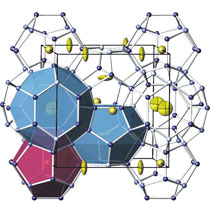New knowledge about thermoelectric materials could give better energy efficiency
Researchers at the University of Århus, Risø-DTU and the University of Copenhagen stand jointly behind new data, just published in Nature Materials, that describes properties of thermoelectric materials, which is of great importance for their practical application. In the long term the new knowledge can be used to develop motors that are more fuel-efficient and for more environmentally friendly cooling methods.
Thermoelectric materials can be assembled into units, which can transform the thermal difference to electrical energy or vice versa - electrical current to cooling. An effective utilization requires however that the material supplies a high voltage and has good electrical, but low thermal conductivity.
- The new knowledge explains exactly why some thermoelectric materials can have the desired low thermal conductivity without degrading the electrical properties. This can be crucial for the conversion of wasted heat, for example, from vehicle exhaust emissions. Leading car manufacturers are now working to develop this possibility and the first models are close to production. The technology is expected to give the cars considerably improved fuel economy, explains Bo B. Iversen, Professor at iNANO at the University of Århus. The new knowledge can also contribute to the development of new cooling methods, so that one avoids the most common, but very environmentally damaging greenhouse gas (R-134a). All of which is a gain for the environment.
In the Nature Materials article the researchers have studied one of the most promising thermoelectric materials in the group of clathrates, which create crystals full of ‘nano-cages'.

The crystal structure of a 'nano-cage'. Where it beforehand was believed that the unique properties of the materials solely could be ascribed to the movements of the heavy 'guest'-atoms in the cages, it has now been shown that the entire atomic scale movements of the cage should be given credit
- By placing a heavy atom in each nano-cage, we can reduce the crystals' ability to conduct heat. Until now we thought that it was the heavy atoms random movements in the cages that were the cause of the poor thermal conductivity, but this has been shown to not be true, explains Asger B. Abrahamsen, senior scientist at Risø-DTU.
The researchers have used the technique of neutron scattering, which gives them opportunity to look into the material and see the atoms' movements.
- Our data shows that, it is rather the atoms' shared pattern of movement that determines the properties of these thermoelectric materials. A discovery that will be significant for the design of new materials that utilize energy even better, explains Kim Lefmann, associate professor at the Nano-Science Center, the Niels Bohr Institute at the University of Copenhagen.
For more information please contact:
Mogens Christensen, INANO, University of Aarhus, Phone +61 2 9717 3133
Asger B. Abrahamsen, Risø-DTU: Phone +45 26 17 87 57
Niels Hessel Andersen, Risø-DTU: Phone +45 22 40 37 11
Kim Lefmann, Nano-Science Center, Niels Bohr Institut, University of Copenhagen
Phone +45 21 25 04 76
Bo B. Iversen, iNANO, University of Aarhus: Phone +45 89 42 39 69
Link to article in Nature Materials.
